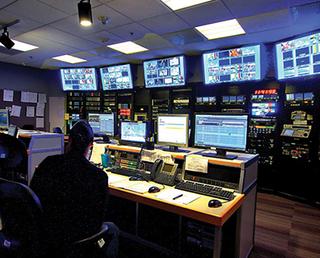Multiviewers Streamline Display Capabilities

KCET-TV in Los Angeles recently installed an XDCAM file-based workflow using Imagine Communications (formerly Harris Broadcast) equipment, including an HView multiviewer.
OTTAWA, ONTARIO—The space, flexibility and cost advantages of multiviewers are winning over TV stations and production facilities. This is why many of them are making the upgrade from dedicated monitor walls.
WOHL-TV and WLIO-TV are sister stations who share production and master control in their Lima, Ohio production facility. The stations hosts and broadcasts four networks: ABC (WOHL 35.1), CBS (WOHL 35.2), NBC (WLIO 8.1) and FOX (WLIO 8.2). Monitoring for the production facility is managed using an Apantac LX32HD multiviewer routed to two 70- inch flat-panel monitors placed side-by- side. From this production room comes all locally produced commercials and shows, as well as 18.5 hours daily of locally produced news for the stations.
“Our monitor wall was comprised of individual monitors, some of which were 18-inches deep,” said Fred Vobbe, WOHL/ WLIO’s chief engineer and vice president. “Reusing these monitors would mean purchasing new racks, which would reduce the usable space within the room.”
In contrast, installing the Apantac multiviewer only consumed four inches of depth, since the power and connection cables were routed through a conduit installed inside the wall cavity. The multiviewer chassis is now rack-mounted in another room and was purchased with an HDMI receiver over Cat-5 option, allowing Vobbe to feed the monitors without using coax.
“The big factor you find with a multiviewer over individual monitors is the pictures are all matched,” Vobbe said. “There is no more guessing if something which is too red or too blue will come out right once it hits air. What you see, is what you get.”
SIMPLIFIED SWITCHOVERS
Quincy Newspapers recently centralized 10 of its stations’ operations using Imagine Communications (formerly Harris Broadcast) equipment, to improve operational efficiency and platform commonality. Among the upgrades includes the ability for three Quincy “hub stations” to monitor/distribute the 10 stations’ 30 on-air broadcasts (primary and two digital subchannels per station), using Imagine Communications routers with built-in SX Pro multiviewers.
The SX Pros make it easy for our people to do a lot of multistation monitoring from one location,” said Brady Dreasler, Quincy Newspapers’ vice president of engineering. “They also can store and switch between multiple monitor configurations. So if you’re going from one studio to an- other for live newscasts, each with their own unique configurations, the switch be- tween monitor feeds can be done with the push of a button.”
When a TV station relocates its facility, it often uses the move as an opportunity to build new, up-to-date facilities, including dumping monitor walls for multiviewers.

WOHL-TV/WLIO-TV in Lima, Ohio, uses an Apantac LX32HD multiviewer routed to two 70-inch flat-panel monitors placed side-by-side for monitoring. This was certainly the case for Los Angeles public television station KCET (Ch. 28).
In 2012, the station moved from its 40 year-old facilities in the former Monogram Pictures facility on Sunset Boulevard to a new facility in Burbank. The broadcaster installed an XDCAM file-based workflow using Imagine Communcations equipment; including a HView multiviewer.
“We sold our old property lock, stock and barrel to the Church of Scientology, al- lowing ourselves to do a full ‘green field’ build that allowed us to drop dedicated monitor walls,” said Gorden Bell, KCET’s senior vice president of engineering, operations and IT. “Moving to the HView al- lows us to feed multiple LED monitors in multiple control rooms, with much more flexibility, less heat and power, and certain- ly far else space than dedicated monitors.”
TABLET CONTROL
New York’s Total Traffic & Weather Net- work (TT&WN) shoots and supplies aerial traffic/news footage to about 200 U.S. TV stations nationwide, from independents to network O & Os. Its New York operation is handled from its Rutherford, N.J. master control and production facility.
Despite the sophistication and timeliness of TT&WN’s New York content, “the fact is that our current master control video monitoring system looks outdated,” admitted Jeff Schick, TT&WN’s director of television engineering. “We’ve got dedicated CRTs plus a bunch of flat panels; it’s a bit of a mess.”
TT&WN is poised to replace this “mess”—plus an older multiviewer that hasn’t lived up to expectations—with several Samsung 50-inch LED monitors and an Ensemble Designs Avenue Multiviewer (MV164) with the company’s new Multiviewer Magic 2.0. This software allows Ensemble Design multiviewers to be con- trolled using an iPad, and supports highly precise offline multiviewer configuration; allowing monitor layouts to be accurately designed without having to look at the multiviewer’s actual video output.
“We really like the idea of being able to configure and control our multiviewers using iPads, and also being able to 16-window our cameras at our Empire State Building 83rd floor facility, which feed our Rutherford facility,” Schick said. “Right now, we have to page through each of the Empire State camera views a feed at a time. That wastes time, and can cause us to miss something newsworthy happening on one of our cameras there, simply because its video I don’t currently have on the monitor.”
Get the TV Tech Newsletter
The professional video industry's #1 source for news, trends and product and tech information. Sign up below.
James Careless is an award-winning journalist who has written for TV Technology since the 1990s. He has covered HDTV from the days of the six competing HDTV formats that led to the 1993 Grand Alliance, and onwards through ATSC 3.0 and OTT. He also writes for Radio World, along with other publications in aerospace, defense, public safety, streaming media, plus the amusement park industry for something different.

